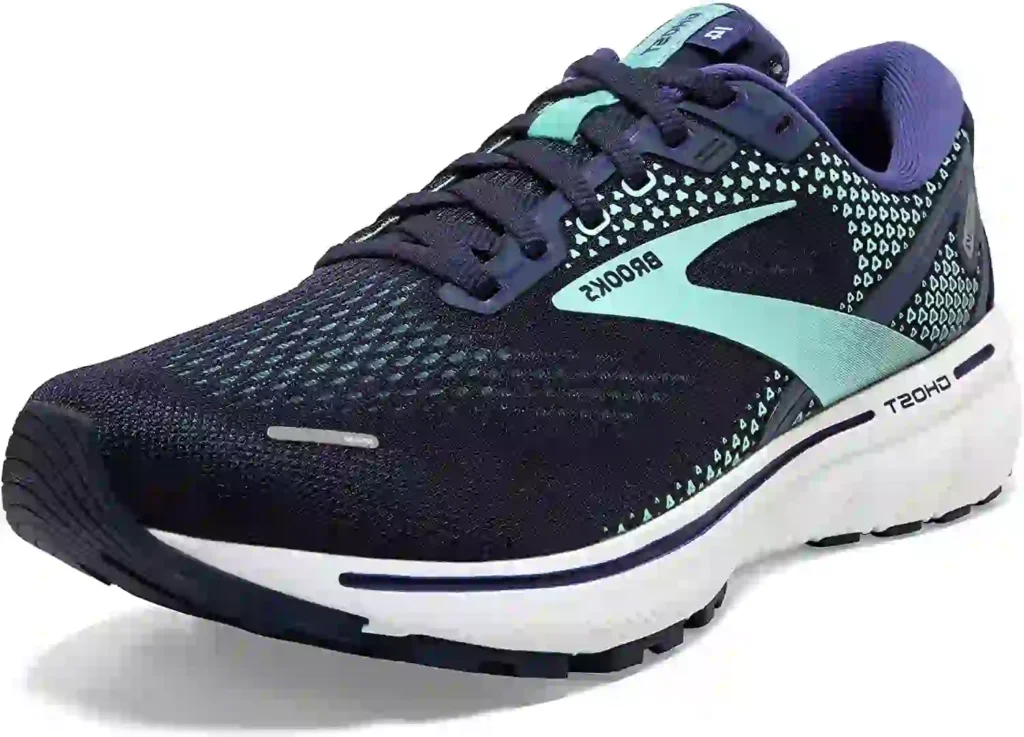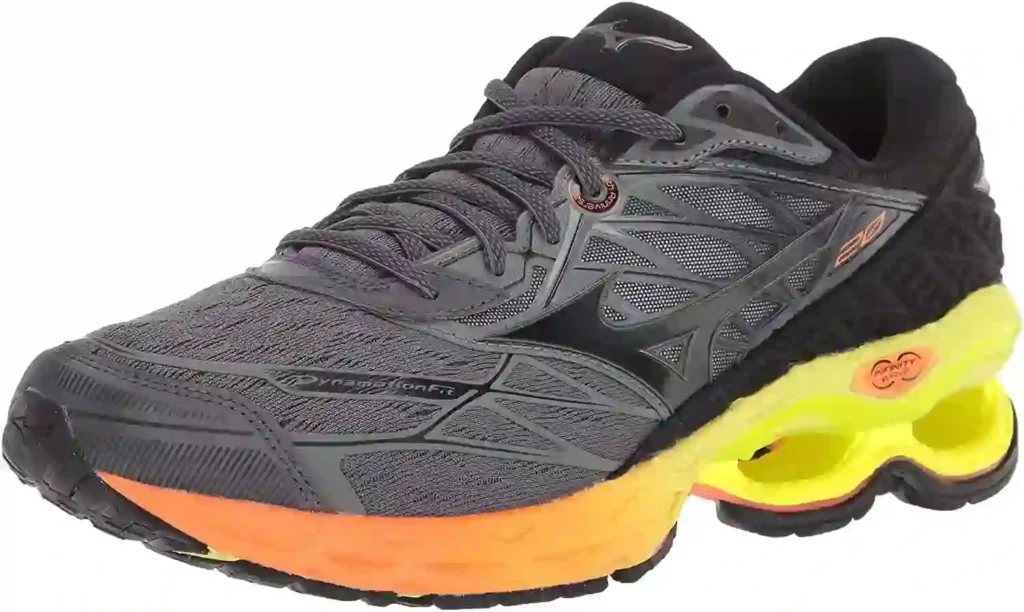Stepping into the world of running with a metatarsal stress fracture can be daunting, but the right footwear is your first stride toward recovery and resilience.
The quest for the best running shoes is not just about comfort; it’s about finding a champion ally that provides exceptional support and cushioning to ease the pressure on your delicate metatarsals.
With the myriad of options out there, it’s crucial to select a pair that promotes optimal healing and prevents further injury.
Let us be your guide on this pivotal journey, as we introduce you to footwear engineered to safeguard your feet, enhance your stability, and help you reclaim the joy of running with confidence and vigor.
To save you time, we have picked Mizuno Men’s Wave Creation 20 as the best running shoe for men.
- Designed to help heal stress fractures
- Arch support for stability and comfort
- Infinity Wave Plate for improved shock absorption
- Midsole for lightweight cushioning
- X10 Outsole for durability
It is a versatile option that can be used for various types of running, making it an ideal choice for those suffering from a stress fracture.
We have discussed in detail stress fracture and recommended different products; please check them out here: Best shoes for a metatarsal stress fracture
What Is A Metatarsal Stress Fracture?
A metatarsal stress fracture is a small crack or severe bruising within one of the metatarsal bones, which are the long bones in the foot that connect the ankle to the toes.
This type of injury typically results from overuse or repetitive force, often seen in athletes, runners, or individuals engaging in high-impact activities without adequate rest.
Early diagnosis and treatment are crucial to prevent further injury and ensure a full recovery.
Resting the affected foot, employing ice and elevation to reduce swelling, and possibly immobilization are key steps in the healing process.
Consulting with a healthcare professional can provide a comprehensive treatment plan, which may include physical therapy to restore strength and function.
Protect your feet, and they will carry you far.
If you do experience a metatarsal stress fracture, you may need to wear a cast or boot for several weeks.
We have discussed how to prevent stress fractures.
Check it out.
Causes Of Metatarsal Stress Fractures
There are several factors that can contribute to the development of metatarsal stress fractures:
- Repetitive Impact: High-impact activities such as running, jumping, or dancing can cause repetitive stress on the metatarsals, leading to tiny cracks in the bones.
- Sudden Increase in Activity: A rapid increase in the intensity, duration, or frequency of physical activity without adequate conditioning can overload the metatarsal bones.
- Poor Footwear: Wearing shoes that do not provide sufficient support or cushioning can increase the risk of stress fractures.
- Hard Surfaces: Training or performing on hard surfaces can increase the stress on the metatarsals.
- Foot Biomechanics: Abnormal foot structure or mechanics, such as high arches, flat feet, or overpronation, can distribute weight unevenly across the foot, leading to increased stress on the metatarsals.
- Osteoporosis or Low Bone Density: Conditions that weaken the bones, such as osteoporosis, can make them more susceptible to fractures, even with normal levels of activity.
- Nutritional Deficiencies: Poor nutrition, particularly a diet low in calcium and vitamin D, can weaken bones and contribute to stress fractures.
- Female Athlete Triad: This condition, which includes disordered eating, amenorrhea (absence of menstruation), and osteoporosis, can increase the risk of stress fractures in female athletes.
- Previous Stress Fractures: Individuals who have had a stress fracture in the past are more likely to experience another one due to potential underlying biomechanical or nutritional issues.
- Muscle Fatigue: When muscles become fatigued, they are less able to absorb shock, transferring more stress to the bones.
- Insufficient Recovery Time: Not allowing enough time for the body to rest and recover between high-impact activities can lead to an accumulation of damage in the bones, resulting in stress fractures.
Preventing metatarsal stress fractures involves addressing these risk factors, such as gradually increasing activity levels, wearing proper footwear, correcting biomechanical issues, maintaining good nutrition, and allowing for adequate rest and recovery.
If a stress fracture is suspected, it is important to seek medical attention to obtain a proper diagnosis and treatment plan.
What Are The Symptoms Of A Metatarsal Stress Fracture?
A metatarsal stress fracture is a small crack or severe bruising within one of the metatarsal bones, which are the long bones in the foot that connect the ankle to the toes.
The symptoms of a metatarsal stress fracture can vary from person to person, but commonly include:
- Pain: This is often the first and most noticeable symptom.
The pain typically develops gradually and worsens with weight-bearing activities.
It may also intensify during exercise and diminish with rest.
- Swelling: The top of the foot or the area around the specific metatarsal bone may appear swollen.
- Tenderness: The area over the stress fracture can be tender to touch.
- Bruising: Sometimes bruising can occur on the top of the foot or on the affected area.
- Difficulty with activities: Activities that put stress on the foot, like running, jumping, or even walking, can become difficult and painful.
- Pain that subsides with rest: Although the pain may be persistent, it often decreases significantly or disappears entirely with rest, only to return when resuming activity.
It’s important to note that stress fractures can get worse with continued stress on the affected area.
If you suspect you have a metatarsal stress fracture, it is advisable to seek medical attention for a proper diagnosis and treatment plan.
Left untreated, a stress fracture can lead to more serious complications, such as a complete fracture or chronic problems in the foot.
Treatment typically involves rest, ice, compression, elevation (RICE protocol), and sometimes immobilization with a boot or cast to allow the bone to heal properly.
How Is A Metatarsal Stress Fracture Treated?
A metatarsal stress fracture is a small crack in one of the long bones of the foot, known as the metatarsals.
This type of injury is common among athletes, particularly those who engage in high-impact sports like running.
Treatment for a metatarsal stress fracture typically includes:
- Rest: The most crucial step in treating a metatarsal stress fracture is to rest the injured foot to avoid further damage.
This means minimizing weight-bearing activities and giving the bone time to heal.
- Ice: Applying ice to the affected area can help reduce swelling and pain.
It is usually recommended to apply ice for 15-20 minutes every few hours for the first couple of days following the injury.
- Elevation: Keeping the injured foot elevated above heart level can help reduce swelling and pain.
- Footwear: Wearing sturdy, supportive shoes can help alleviate pressure on the foot.
In some cases, a doctor may recommend a special walking boot or a stiff-soled shoe to protect the fractured bone while it heals.
- Immobilization: Depending on the severity of the fracture, a cast or a removable brace may be used to immobilize the foot and allow the bone to heal properly.
- Physical therapy: Once the initial healing has taken place, physical therapy exercises may be recommended to strengthen the foot and restore range of motion.
- Gradual return to activity: It’s important to slowly increase activity levels according to the guidance of a healthcare professional to prevent re-injury.
- Medications: Over-the-counter pain relievers such as ibuprofen or acetaminophen can help manage pain.
It’s important to consult with a doctor before taking any medication to ensure it’s safe and won’t interfere with bone healing.
- Modification of activities: Changing exercise patterns or modifying techniques may be necessary to prevent future stress fractures.
- Nutritional support: Adequate calcium and vitamin D intake is important for bone health.
A healthcare provider may recommend dietary changes or supplements to support the healing process.
The healing time for a metatarsal stress fracture can vary, typically ranging from 4 to 8 weeks or longer, depending on the severity of the fracture and the individual’s overall health.
It’s essential to follow the treatment plan prescribed by a healthcare professional and to avoid returning to high-impact activities too soon to ensure the fracture heals completely and to minimize the risk of chronic problems.
Regular follow-up appointments may be necessary to monitor the progress of the healing.
best running shoes for stress fractures
![What are Best Running Shoes For Metatarsal Stress Fracture [Explained]](https://gearim.com/wp-content/uploads/2022/06/What-are-Best-Running-Shoes-For-Metatarsal-Stress-Fracture-Explained.webp)
1. Brooks Women’s Ghost 14 Neutral – Best Running Shoes for Metatarsalgia Pain
If you’re looking for a running shoe that provides a smooth-as-silk ride, look no further than the Brooks Ghost 14.
This shoe is designed to fit your form snugly and keep your feet cushioned, giving you an elevated running experience.
The Ghost 14 is also an excellent choice for runners recovering from a metatarsal stress fracture, as its rubber sole provides plenty of cushioning and support.
These shoes have a lightweight and breathable mesh upper and an imported rubber sole that provides cushioning and traction.
They also help keep your foot in place, ensuring a smooth and comfortable run.
Key Benefits
- It provides a smooth-as-silk ride so that you can run with less fatigue
- Keeps your feet cushioned so that you can run longer and faster
- It keeps your feet cool so that you can run in comfort
- Provides long-lasting support
- Keeps you comfortable
- Keeps you running
2. Mizuno Men’s Wave Creation 20 Running Shoe for Stress Fracture
I’m a big fan of Mizuno running shoes.
I have a few different pairs, and I love them all.
I was excited to try the Wave Creation 20’s and wasn’t disappointed.
They are super comfortable and have great support.
The cushioning is incredible and makes running a lot more comfortable.
The new premium sock liner also adds a layer of comfort that I appreciate.
The air mesh upper makes the shoe feel incredibly light and breathable, which is excellent for hot summer runs.
They are perfect for long runs or just everyday wear.
I would highly recommend these shoes to anyone!
Key Benefits
- More cushioned than the Wave Creation 20 for a smoother ride
- Provides a stable platform for quick, efficient strides
- It keeps your feet cool and dry for better comfort and performance
- Lightweight, breathable and comfortable
- It provides a smooth transition and a cushioned ride
- Provides a snug, secure fit
3. New Balance 860v7 Running shoes for metatarsal stress pain
I love my new New Balance 860v7 shoes!
They are so comfortable and provide excellent support, which is precisely what I need since I am recovering from a metatarsal stress fracture.
The rubber sole makes them durable, and the Fresh Foam midsole cushioning makes them lightweight, which is perfect for me since I have to be careful not to put too much weight on my foot.
I’ve been wearing them for about two months now and have had no problems with them.
I have a metatarsal stress fracture, and these shoes have been great for me.
They have a molded insert that helps provide extra support, which I need.
Key Features
- The engineered mesh upper allows for breathability
- Designed to help reduce the risk of injury and provide a smooth ride
- The rubber sole allows for a stable and comfortable ride
- The Fresh Foam midsole cushioning offers exceptional comfort in a lightweight package
Frequently Asked Questions
What shoes to wear after metatarsal fracture?
Wear stable, cushioned, and supportive shoes, possibly with a stiff sole.
Orthopedic or specially designed post-injury footwear with a metatarsal pad can also help.
How do I start running after a metatarsal stress fracture?
Gradually return to running after being cleared by a healthcare professional.
Begin with low-impact activities, then slowly increase distance and intensity, listening to your body and stopping if you feel pain.
What shoes should I wear with a stress fracture?
Choose shoes that provide ample cushioning, support, and possibly motion control.
Avoid high heels or flat, unsupportive footwear.
Are Hokas good for stress fractures?
Hoka shoes, known for their cushioning, can be good for stress fractures as they reduce impact forces on the foot, but individual fit and specific needs should also be considered.
Always consult a healthcare professional for personalized advice.
Conclusion
The best running shoes for metatarsal stress fractures provide ample cushioning and stability.
They should also be lightweight and comfortable to minimize the stress placed on the foot.
If you are suffering from a metatarsal stress fracture, be sure to consult with your doctor or physical therapist to determine which type of shoe is best for you.
Useful Links:




